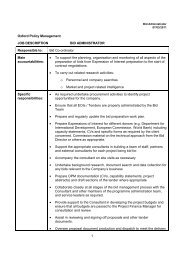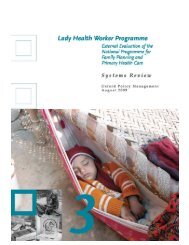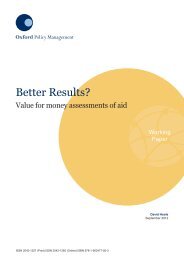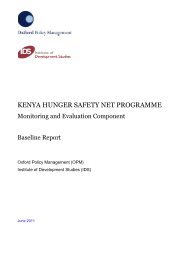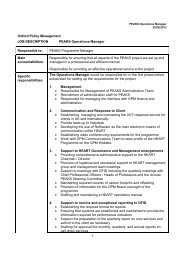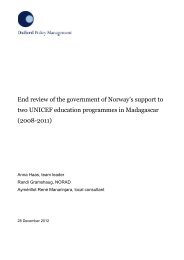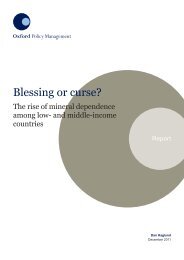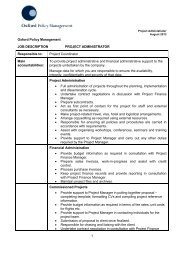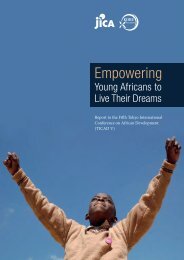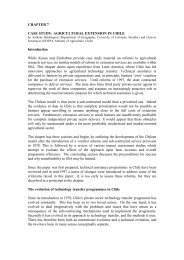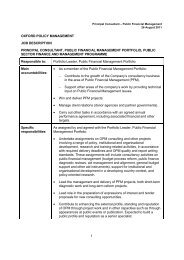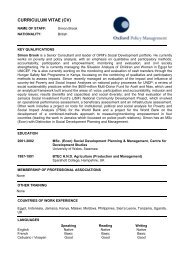LHW Punjab and ICT Report - Oxford Policy Management
LHW Punjab and ICT Report - Oxford Policy Management
LHW Punjab and ICT Report - Oxford Policy Management
Create successful ePaper yourself
Turn your PDF publications into a flip-book with our unique Google optimized e-Paper software.
LADY HEALTH WORKER EVALUATION – PUNJAB AND <strong>ICT</strong> SURVEY REPORTInformation provided by <strong>LHW</strong>s confirms that curative services are an important partof their workload. Indeed, well over half of the cases seen by <strong>LHW</strong>s are curative rather thanpreventive. This might be due to <strong>LHW</strong>s being more likely to report a client who was ill thanto report the delivery of routine preventive services. Treating fever <strong>and</strong> respiratory infections<strong>and</strong> routine family planning visits were the most commonly reported activities.Table 2-1 Consulting the Lady Health Worker for Illness or Injury- by ProvinceMeasure<strong>Punjab</strong>& <strong>ICT</strong>Sindh NWFP& FATABalochistanAJK& NAs% of individuals who were ill or injured in theprevious fourteen days who consulted the<strong>LHW</strong> –if they consulted anyone at all:20 13 18 18 32<strong>LHW</strong>s were also asked to report on the last emergency case seen – that is, the lastcase that they saw who required immediate referral to a health facility. Throughout thecountry, almost nineteen percent had never seen such a case. Presumably this reflects the useof other providers. For those who had seen an emergency case, complications of delivery <strong>and</strong>pregnancy, together with respiratory infections <strong>and</strong> severe dehydration, were the mostcommon. This suggests that <strong>LHW</strong>s are playing a useful role in the identification <strong>and</strong> referralof serious cases.ACTIVITIES IN THE COMMUNITYThe <strong>LHW</strong> is responsible for mobilising the community to promote <strong>and</strong> improve healththrough her participation in the health committee <strong>and</strong> in the women’s health committee.While across the country these committees are not taking off, there is a positive perception ofthe work of most <strong>LHW</strong>s. In <strong>Punjab</strong> <strong>and</strong> <strong>ICT</strong>, four out of five communities reported that the<strong>LHW</strong> has generally improved people’s life in the village <strong>and</strong> eighty-nine percent reportedthat once the women had become an <strong>LHW</strong>, she was usually respected.REFERRAL TO HEALTH FACILITIESOne objective of the <strong>LHW</strong>P was to improve the utilisation of public health facilities throughclient referrals. Private facilities are often not accessible in rural areas or are too expensivefor the poor to afford. Adequate publicly provided services that are either free or cheap at thepoint of delivery are therefore an important part of improving community health.Unfortunately, nation-wide, staffing <strong>and</strong> supplies at the health facilities that the<strong>LHW</strong>s are attached to are often very poor <strong>and</strong> some of the communities where <strong>LHW</strong>s workare under-served by vaccination services. 12 We found clinical support services on which<strong>LHW</strong>s depend are inadequate which would limit the effectiveness of the <strong>LHW</strong>s referral role.12 See the Quantitative Survey <strong>Report</strong> for information on services at health facilities.8



